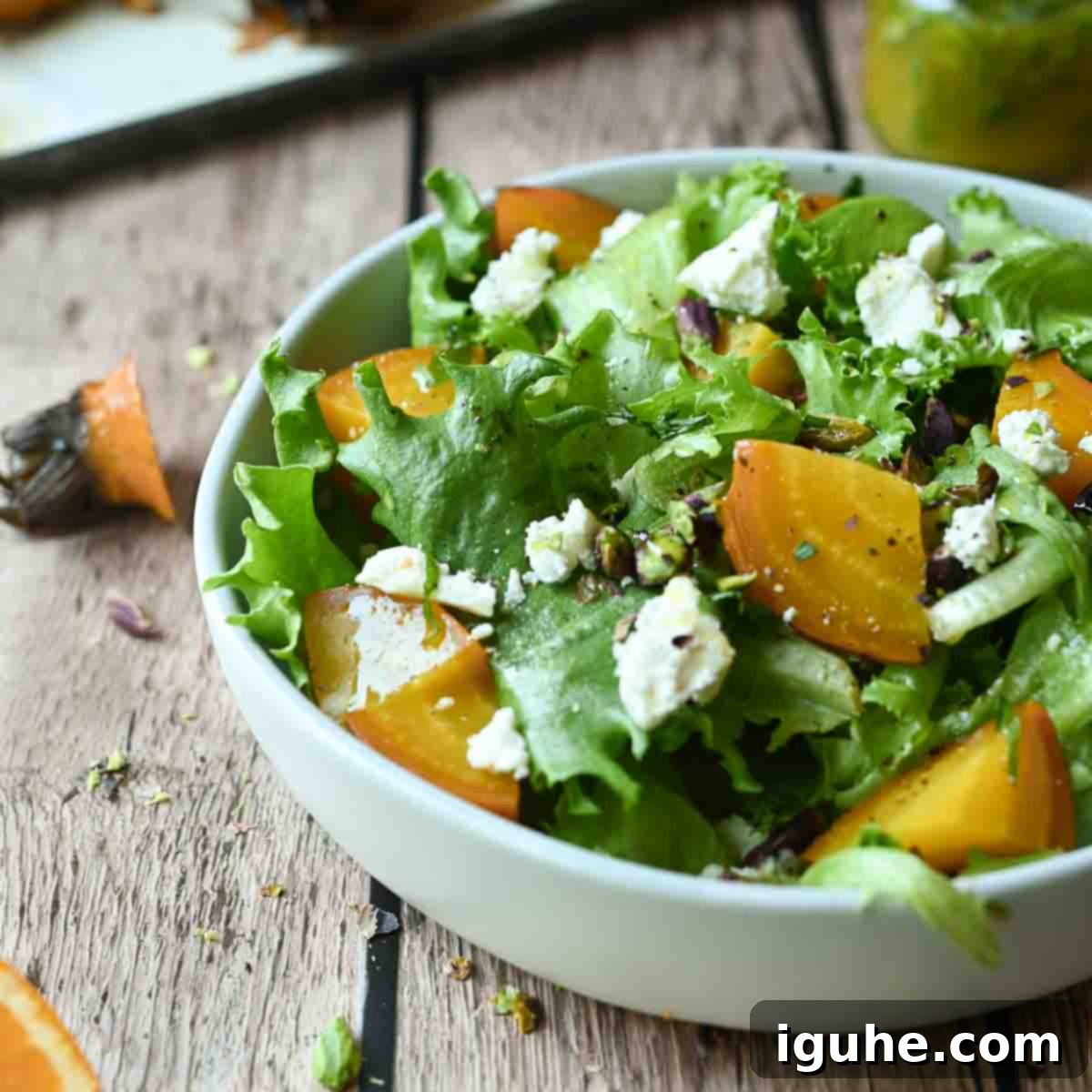Vibrant Golden Beet Salad with Herbaceous Tarragon Vinaigrette: A Burst of Sunshine on Your Plate
Prepare to delight your senses with this exquisite Golden Beet Salad with Tarragon Vinaigrette, a dish that truly embodies the warmth and vibrancy of sunshine. This recipe masterfully combines the sweet, earthy flavors of roasted golden (yellow) beets with the crisp freshness of mixed greens, the salty creaminess of feta cheese, and the satisfying crunch of toasted pistachios. What ties it all together is a bright, herbaceous tarragon dressing, adding a sophisticated anise-like note that elevates every bite. It’s not just a salad; it’s an experience designed to brighten any meal.
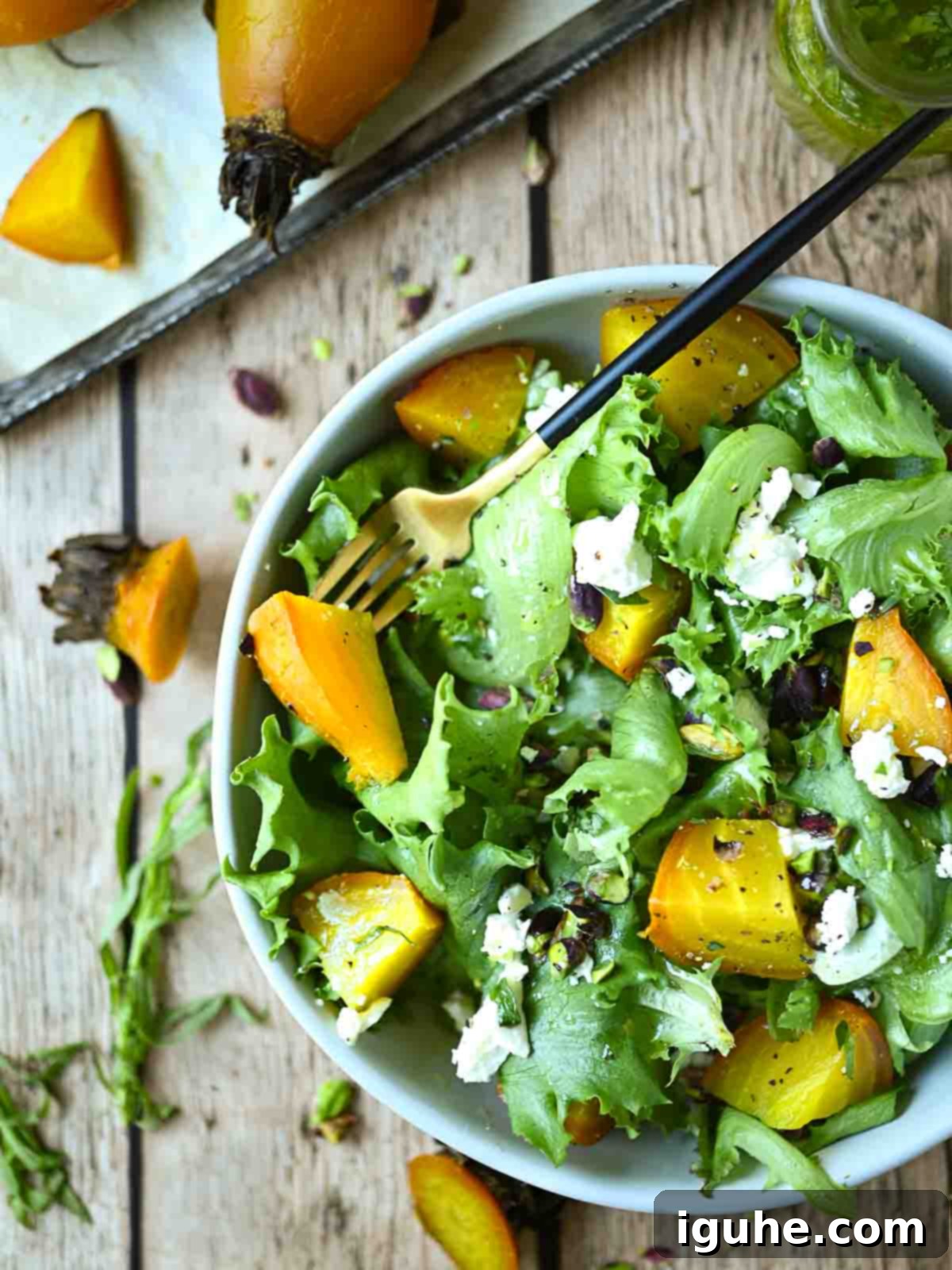
My culinary journey often leads me to the vibrant stalls of local farmers’ markets, where the freshest seasonal produce inspires new creations. Lately, I’ve been obsessed with crafting beautiful and flavorful salads, and my latest market find – the magnificent golden beet – has taken center stage. While its cousin, the red beet, is well-loved, golden beets offer a unique advantage: all the delightful flavor without any of the staining mess. Plus, many find their taste profile even more appealing.
Golden beets are celebrated for their inherently sweeter and milder flavor compared to red beets. They lack the intense “earthiness” that some find off-putting in their red counterparts. When roasted, as we do in this recipe, these yellow beauties transform. Their natural sugars caramelize, intensifying their sweetness and developing a wonderfully rich, tender, and almost buttery texture with a subtle nutty undertone. This gentle sweetness makes them incredibly versatile and a perfect canvas for a zesty dressing.
The magic truly happens when this exquisite beet salad is generously finished with a homemade tarragon vinaigrette. Tarragon, an herb often described as having distinct notes of anise or licorice, combined with a fresh, earthy taste, beautifully complements the mildness of the golden beets. The bright, slightly pungent flavor of the dressing provides a delightful contrast to the sweet beets and creamy feta, creating a harmonious blend of tastes and textures that will undoubtedly impress. This salad isn’t just good; it’s un-beet-able!
Why You’ll Adore This Golden Beet Salad Recipe
This golden beet salad isn’t just a simple dish; it’s a culinary highlight that offers numerous reasons to fall in love:
- Light and Refreshing: Perfect for a warm day or as a vibrant side, its fresh ingredients leave you feeling energized and satisfied without being heavy.
- Visually Stunning: The cheerful golden hue of the beets, contrasted with vibrant greens and white feta, creates an incredibly appealing presentation that will “wow” your guests.
- Quick Assembly: Once the beets are roasted (which can be done ahead of time), the rest of the salad comes together in mere minutes, making it ideal for busy weeknights or impromptu gatherings.
- No Red Staining: Say goodbye to stained hands and cutting boards! Golden beets offer all the deliciousness of beets without the pigment fuss associated with their red relatives.
- Embrace New Flavors: This recipe is a fantastic way to introduce a unique vegetable to your diet or creatively utilize a haul from your local CSA (Community Supported Agriculture) box.
- Health Benefits: Beets are packed with essential vitamins, minerals, and antioxidants, making this salad as nutritious as it is delicious.
Essential Ingredients for Your Golden Beet Salad
Crafting this exquisite golden beet salad with tarragon vinaigrette relies on the freshest, highest-quality ingredients. Each component plays a vital role in creating the overall balance of flavors and textures.
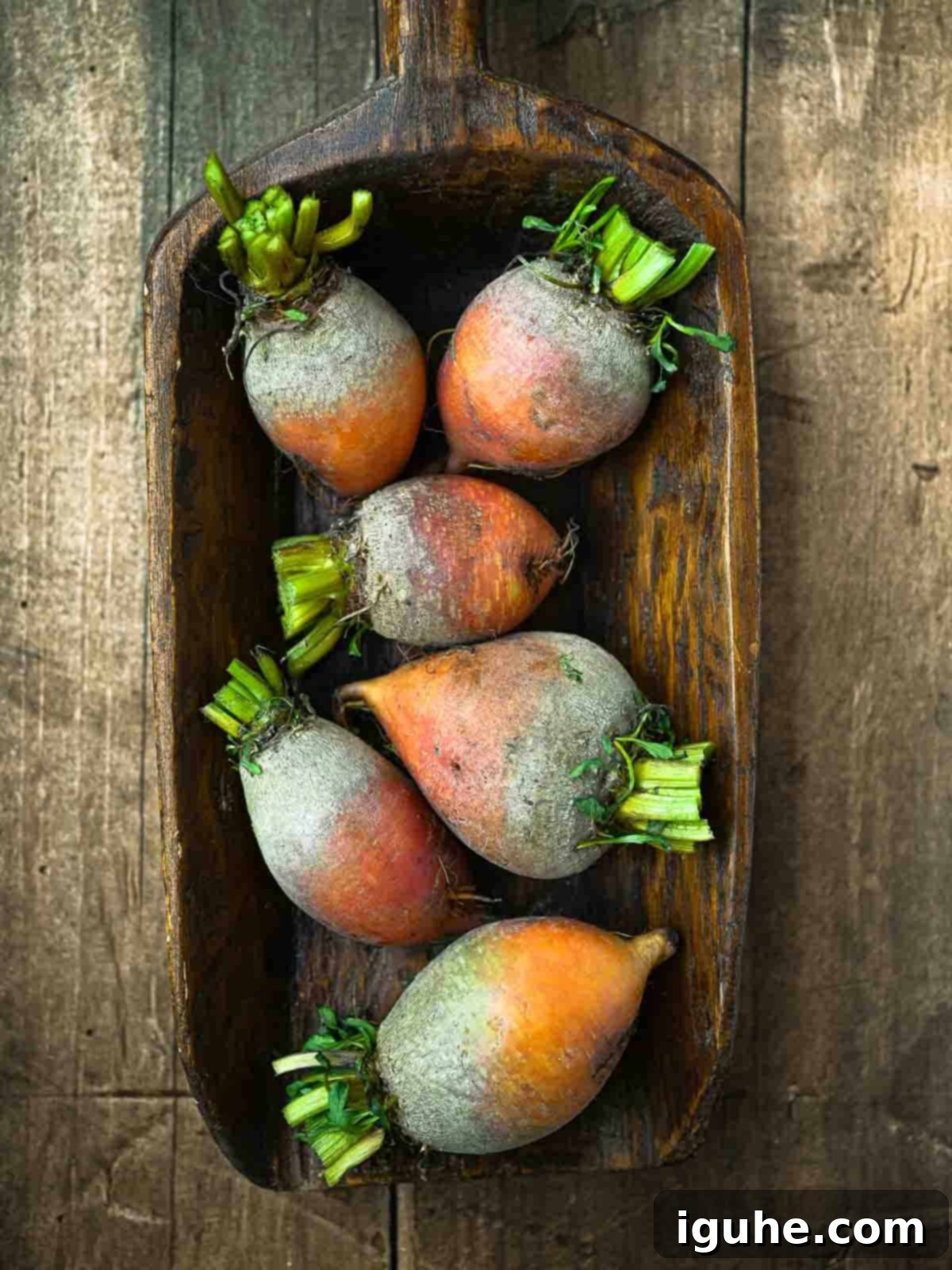
- Golden Beets: Also affectionately known as “yellow beets” or “beetroot,” these are the star of our show. They boast a distinctly sweeter and milder profile than red beets, lacking the strong earthy notes. For the best flavor and texture, seek them out at your local farmer’s market or well-stocked grocery stores, prioritizing local and fresh whenever possible. While fresh red beets can be substituted, remember they will stain and have a more robust, earthy flavor. Canned beets are not recommended for this recipe, as the roasting process is crucial for developing their tender texture and rich, sweet flavor.
- Feta Cheese: My preference is always to buy feta in a block and crumble it myself. This ensures the freshest taste and a delightful creamy yet crumbly texture. Its salty tang perfectly complements the sweetness of the beets. If feta isn’t your favorite, consider other fantastic alternatives like tangy goat cheese, salty Parmesan, or even a milder ricotta salata for a different twist.
- Pistachios: These vibrant green nuts add a wonderful crunch and a touch of color to the salad. For optimal flavor and aroma, I highly recommend toasting them lightly before adding them. If pistachios aren’t available, walnuts, almonds, or even crunchy sunflower seeds make excellent substitutions, each offering a unique textural element.
- Lettuce: A good base is key. A tender Spring mix is my go-to for its delicate leaves and varied textures. However, peppery arugula or crisp Romaine lettuce are equally excellent choices, each bringing its own characteristic flavor to the overall composition.
- Tarragon: Fresh tarragon is truly essential for the vinaigrette. Its unique anise-like and fresh herbaceous notes are distinct and hard to replicate. While dried tarragon can be used in a pinch, fresh will provide a far superior aroma and flavor to the dressing.
- Olive Oil: A high-quality extra virgin olive oil is recommended for both flavor and its health benefits, forming the base of our vinaigrette. Its fruity notes will enhance the overall dressing.
- Orange Juice: Freshly squeezed orange juice is crucial for the vinaigrette. It adds a bright, natural sweetness and acidity that balances the richness of the oil and the earthiness of the beets.
- Dijon Mustard: This ingredient is not just for flavor; it acts as an emulsifier in the dressing, helping to bind the oil and juice together while adding a subtle tangy, acidic kick.
- Honey: A touch of honey perfectly balances the acidity of the orange juice and Dijon, adding a gentle sweetness to the vinaigrette that harmonizes with the naturally sweet beets.
- Salt and Pepper: Essential for seasoning both the vinaigrette and the finished salad. Always adjust to your personal taste preferences.
Mastering the Art of Roasting Yellow Beets
Roasting is the transformative step that unlocks the incredibly sweet and tender essence of golden beets. The process is simple, allowing the oven’s gentle heat to work its magic.
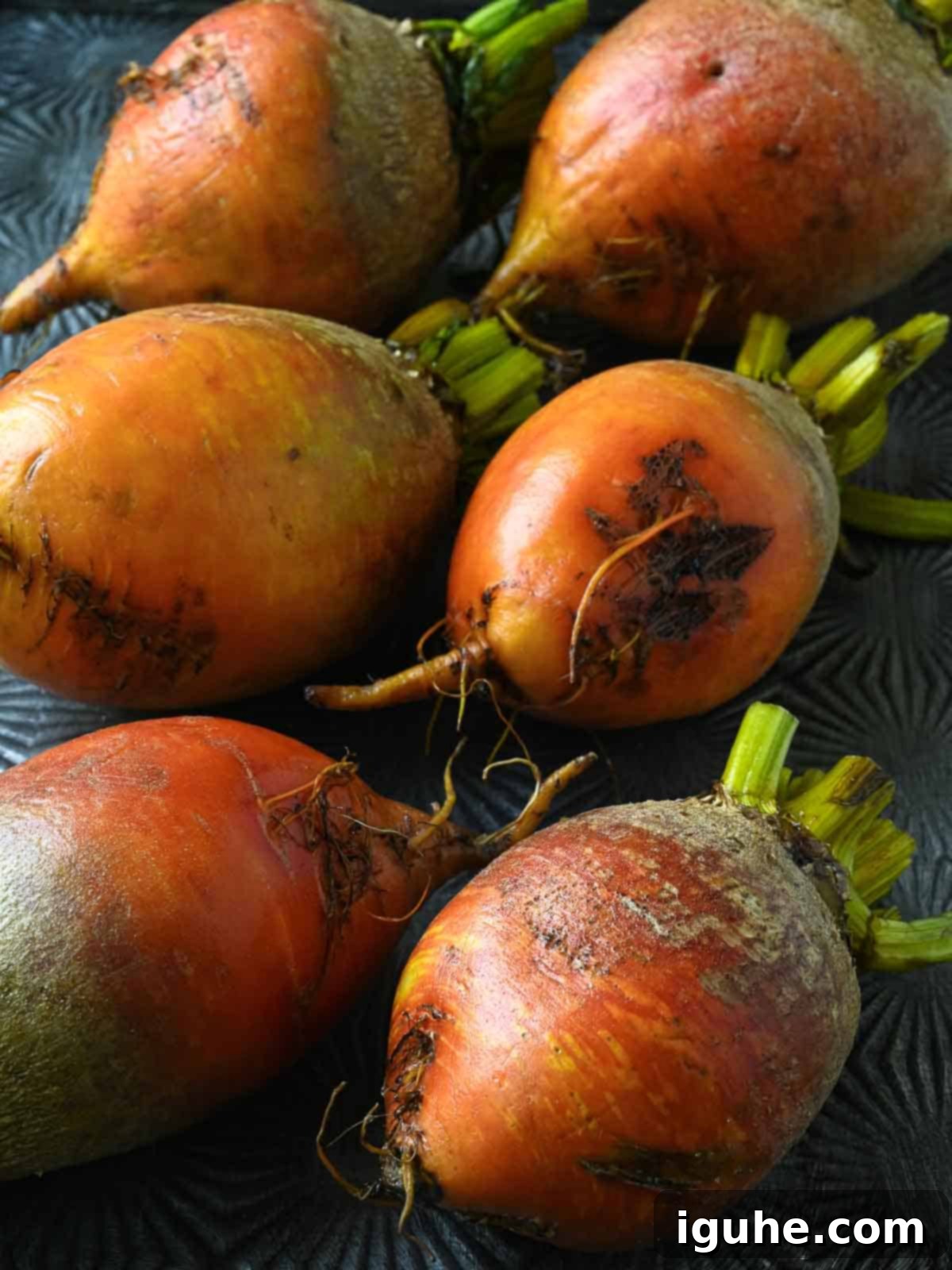
First, prepare your beets by trimming off the leafy green ends. Then, wash the beets thoroughly under cool running water, using a brush or your hands to gently scrub away any soil or debris. There’s no need to peel the beets at this stage; the skins will easily slip off once they’re roasted and cooled.
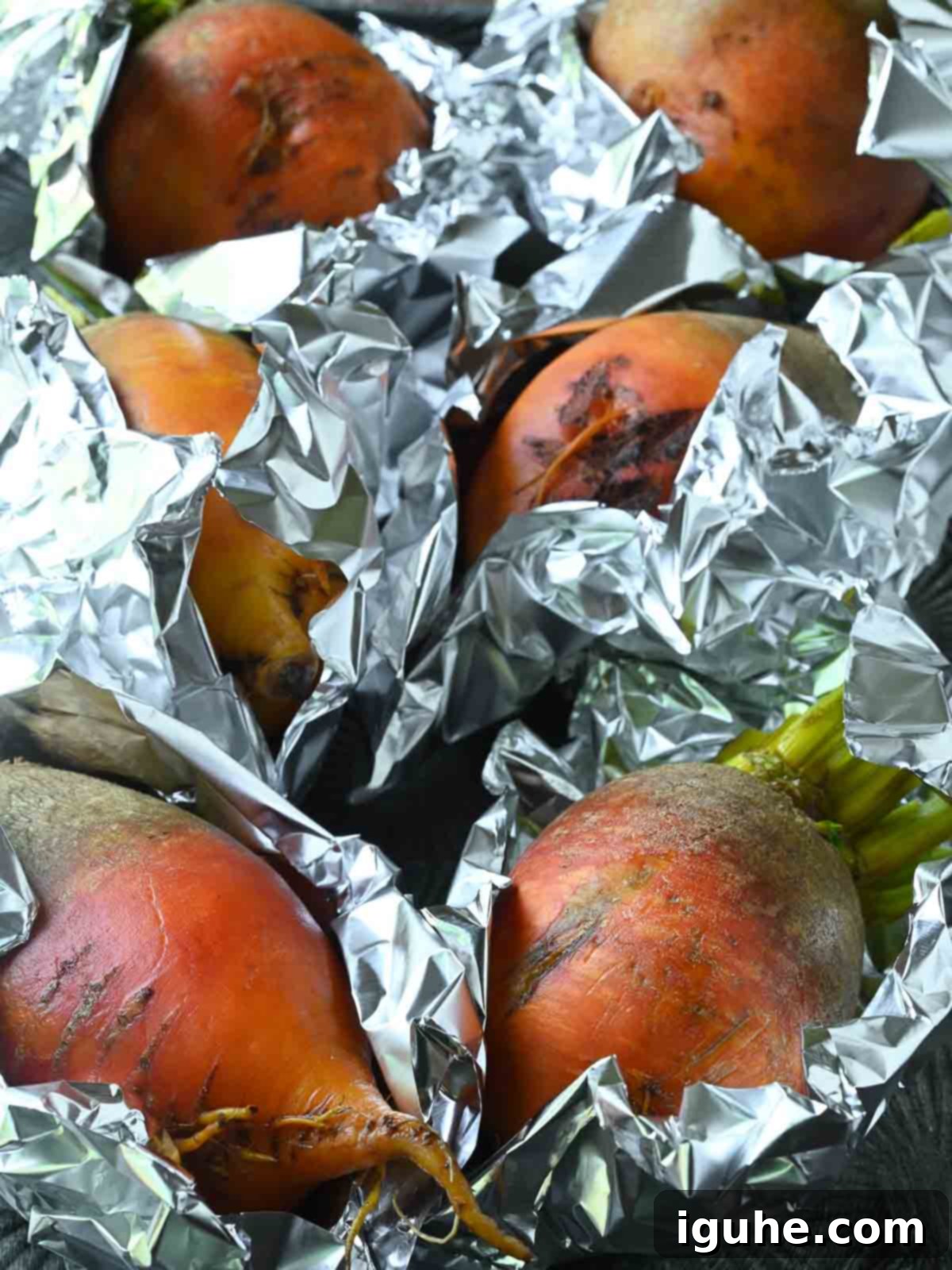
Next, gather several sheets of aluminum foil. Cut each piece large enough to completely enclose a single beet, creating a tightly sealed packet. This foil wrapper helps to steam the beets while they roast, ensuring they become incredibly tender and retain their moisture.
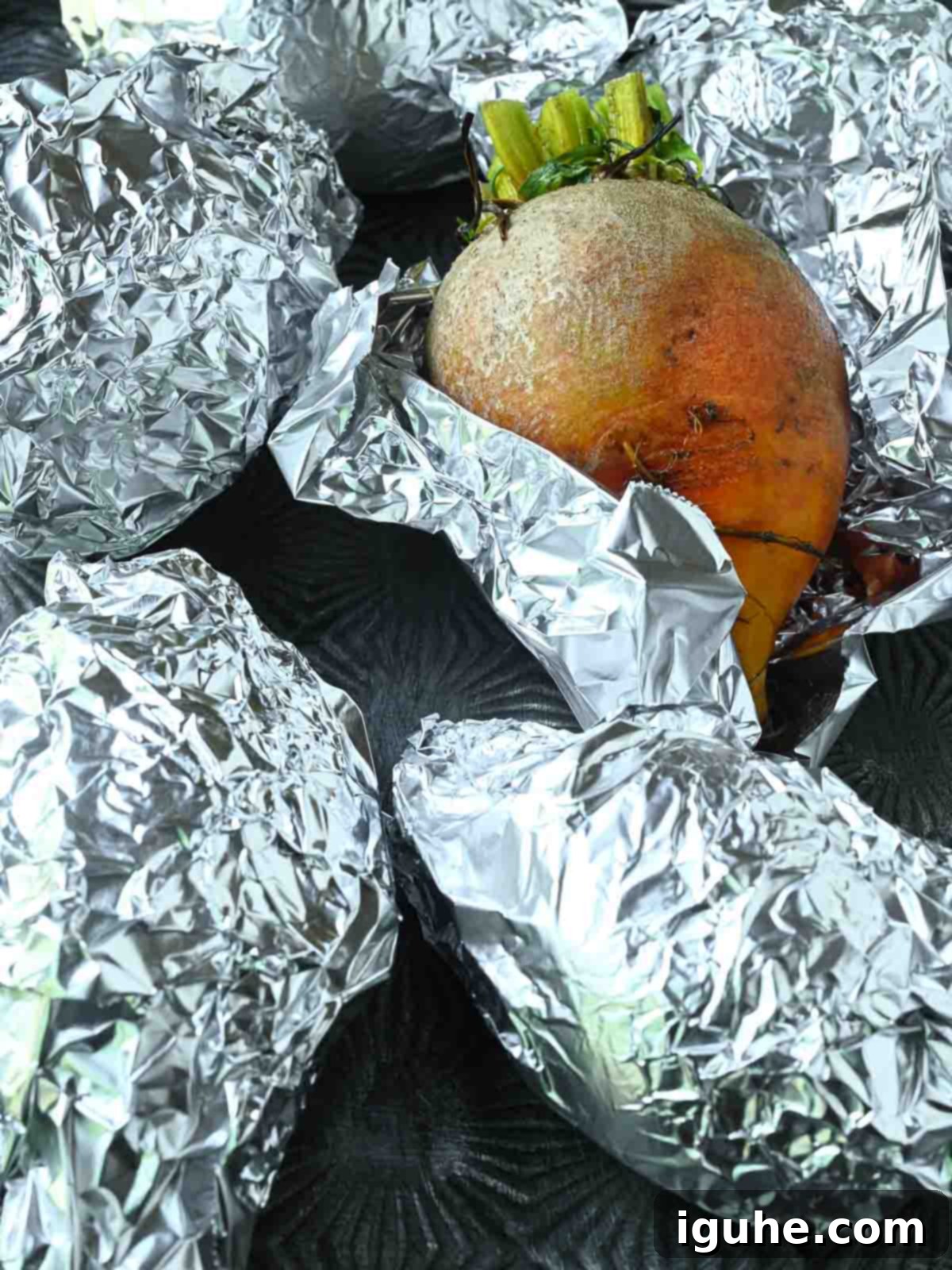
Wrap each beet individually in its foil packet and arrange them on a baking sheet. Place the baking sheet into a preheated oven at 400°F (200°C) and roast for approximately 50 minutes. The cooking time may vary slightly depending on the size of your beets. To check for doneness, carefully unwrap one beet and try to pierce it with a knife; it should slide in easily, indicating a tender, not mushy, consistency.
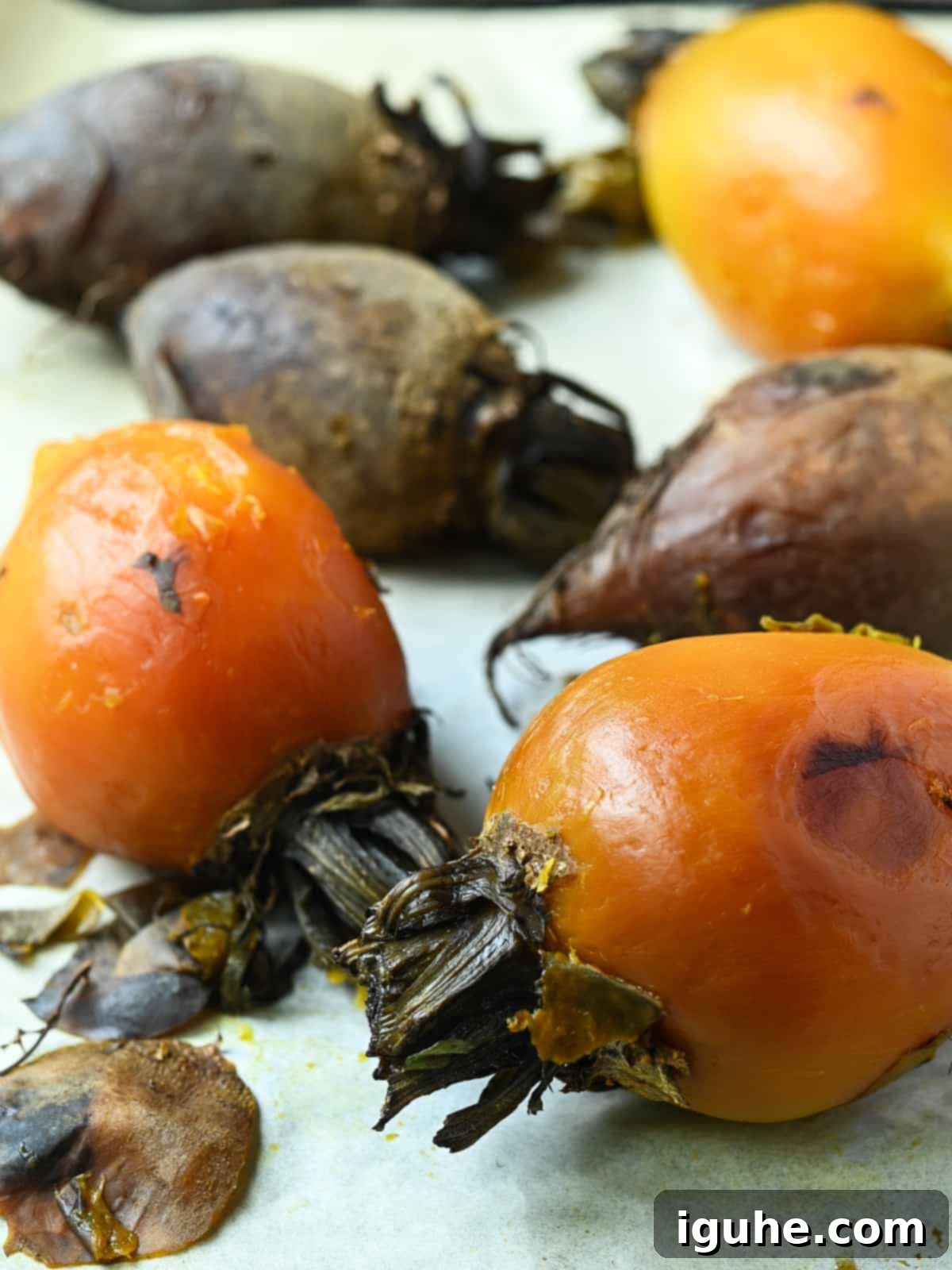
Once roasted, allow the beets to cool completely within their foil packets. This allows them to continue steaming slightly and makes the peeling process incredibly easy. When they are cool enough to handle comfortably, remove the foil and gently rub the skins between your fingers. The skin should effortlessly slide right off, revealing the beautiful golden flesh beneath. You can then cut them into your desired shape for the salad.
💡 Expert Tip for Effortless Beet Peeling
For the easiest beet peeling experience, hold the cooled, roasted beet under cool running water. Use your hands or a piece of paper towel to gently rub the skin. The skins, softened by the roasting process, should slip right off with minimal effort. If you encounter any particularly stubborn spots, a small paring knife can be used to lightly scrape away the remaining skin. This method keeps your hands cleaner and simplifies the preparation process.
Customizing Your Golden Beet Salad: Substitutions and Variations
This golden beetroot salad is incredibly versatile, allowing for a multitude of customizations to suit your taste preferences or whatever ingredients you have on hand. Don’t be afraid to experiment!
- Add Fresh Tomatoes: Tomatoes and beets are a match made in culinary heaven. Halve some sweet cherry tomatoes or dice larger ones and toss them into the salad for an extra burst of juicy freshness and vibrant color.
- Experiment with Cheeses: While feta provides a fantastic salty tang, explore other cheeses. Creamy goat cheese offers a delightful tang and soft texture, Parmesan adds a sharp, nutty flavor, and ricotta salata brings a milder, firmer saltiness.
- Herb Alternatives for the Vinaigrette: If fresh tarragon is unavailable, fresh thyme makes an excellent substitute in the dressing. Its delicate, earthy notes will still complement the beets beautifully. Alternatively, a blend of fresh parsley and chives can also offer a lovely aromatic touch.
- Diverse Nuts or Seeds: Beyond pistachios, crunchy walnuts or almonds offer a different nutty flavor profile. For a unique twist, try toasted hazelnuts. If you prefer seeds, pumpkin seeds (pepitas) or sunflower seeds add a satisfying crunch and a good dose of nutrients.
- Introduce More Vegetables: Enhance the texture and nutritional value by adding other crisp vegetables. Sliced cucumbers provide a cool, refreshing element, while thinly sliced radishes contribute a peppery bite and beautiful color.
- Citrus Zest: A pinch of orange or lemon zest in the vinaigrette can brighten the flavors even further, adding an aromatic depth.
Serving Suggestions for Your Golden Beet Salad
This delectable summertime salad is incredibly versatile and can be enjoyed in countless ways. Whether you’re looking for a light lunch, an elegant side, or a hearty addition to your breakfast, this golden beet salad fits the bill.
Enjoy it as a standalone light meal, especially refreshing on a warm day. Its vibrant flavors and satisfying textures make it a complete and fulfilling option. As a side salad, it pairs exceptionally well with a variety of main courses. Imagine it alongside a classic sandwich, like a fresh, summery strawberry BLT, where its brightness can cut through the richness. It also complements grilled chicken, fish, or vegetarian main dishes beautifully. For a delightful brunch or breakfast, serve it alongside some fluffy scrambled eggs with feta and dill, creating a balanced and flavorful start to your day.
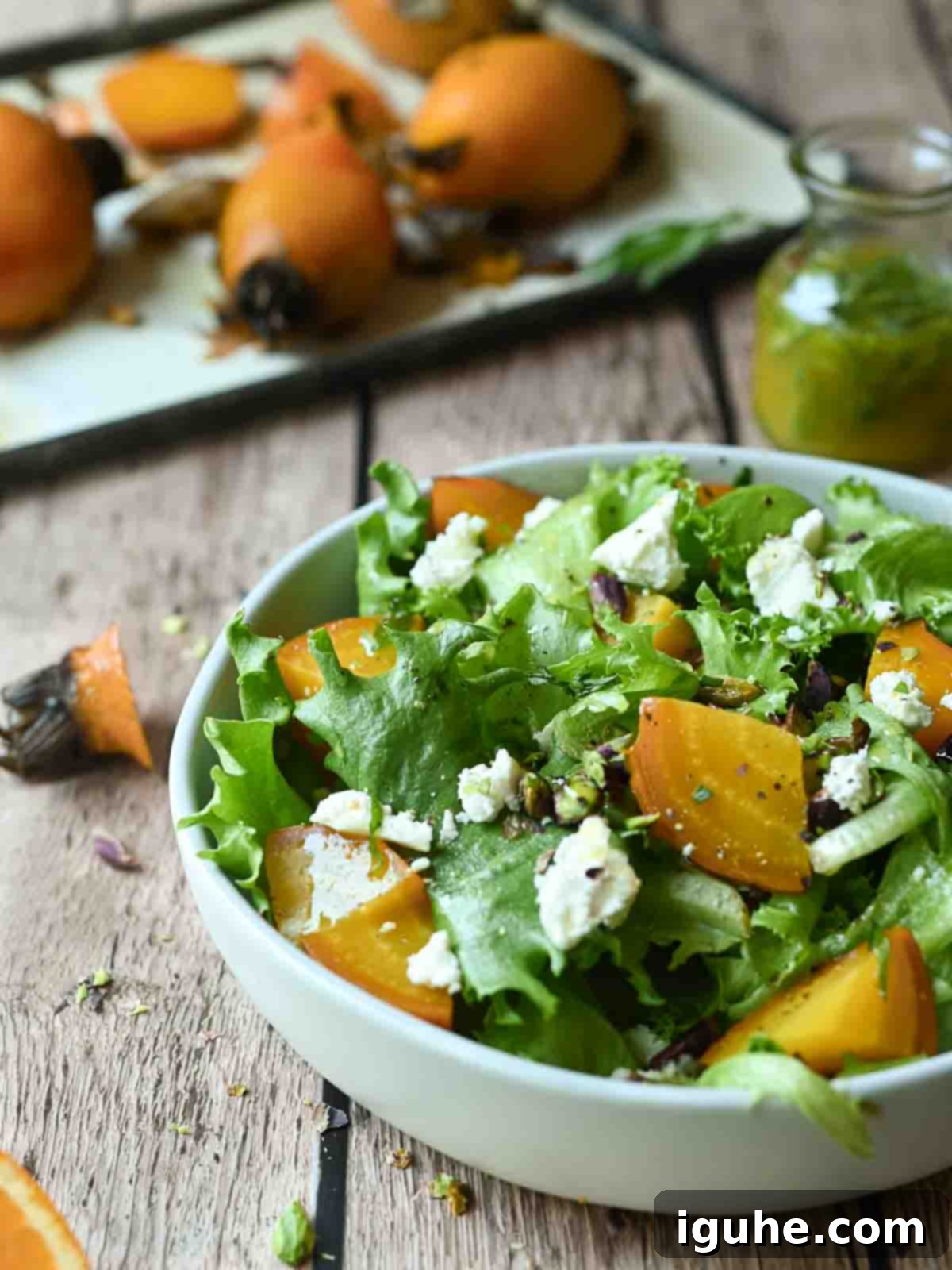
Storage and Make-Ahead Tips
Efficiency in the kitchen is key, and this recipe offers several make-ahead options to simplify your meal prep:
- Roast Beets in Advance: The roasted golden beets are perfect for prepping ahead. Once cooked and peeled, allow them to cool completely. Store them in an airtight container in the refrigerator for up to 3 to 5 days. For even quicker assembly later, you can dice or slice them before storage.
- Proper Beet Storage: Ensure the roasted beets are completely cooled before sealing them in an airtight container. This prevents condensation which can lead to sogginess or spoilage.
- Prepare the Vinaigrette Ahead: The tarragon vinaigrette can also be made in advance and stored in a sealed jar in the refrigerator for up to one week. In fact, its flavors tend to meld and deepen over time, often tasting even better the next day. Before serving, give the dressing a vigorous shake or whisk to re-emulsify it, as the oil and other liquids may separate during storage.
Frequently Asked Questions About Golden Beet Salad
Golden (yellow) beets are often a seasonal specialty. You’ll have the best luck finding them at local farmers’ markets, particularly from late spring through fall. Many specialty grocery stores and larger supermarket chains also carry them when they are in season. If you have a local CSA, they are a common item in seasonal produce boxes.
One of the greatest advantages of golden beets is their minimal staining. While they can leave a faint yellow tint on your hands or cutting board, it’s far less intense and much easier to clean than the deep red pigment from their red counterparts. This makes them a more kitchen-friendly option for many cooks.
Absolutely! Red beets can be used as a substitute, and the overall flavor profile of the salad will still be delicious and complementary. However, be mindful of a few differences: red beets will likely stain your hands, cutting board, and potentially the lettuce. Additionally, red beets tend to have a more pronounced earthy flavor and are typically less sweet than golden beets, which will subtly alter the final taste of the salad.
Perfect Pairings
This versatile golden beet salad makes a wonderful accompaniment to a range of meals, enhancing everything from breakfast to dinner:
- Swiss Chard Eggs Florentine with Tomato Hollandaise
- Broccolini Frittata with Bacon and Parmesan
- Sun Dried Tomato Tuna Melt
- Tomato Leek and Feta Quiche
Did you create this recipe? We’d be thrilled to hear about your experience! Please leave a ⭐⭐⭐⭐⭐ rating and a comment below. If you captured a photo of your beautiful creation, remember to tag us on Instagram @brunchandbatter.
📖 Recipe: Golden Beet Salad with Tarragon Vinaigrette
Have you ever eaten a bowl of sunshine? This Golden Beet Salad with Tarragon Vinaigrette is truly sunshine in a bowl. Glorious, colorful roasted golden (yellow) beets are paired with crisp lettuce, creamy feta, toasted pistachios, and a flavorful, herby tarragon dressing.
Prep Time: 10 minutes
Cook Time: 50 minutes
Cooling Time: 15 minutes
Total Time: 1 hour 15 minutes
Course: Lunch, Salad, Side Dish
Cuisine: American
Servings: 4
Calories: 209 kcal per serving (estimate)
Equipment
- Baking sheet
- Aluminum foil
- Large bowl or jar with a tight-fitting lid (for vinaigrette)
Ingredients
For the Tarragon Vinaigrette:
- ¼ cup freshly squeezed orange juice
- ¼ cup chopped fresh tarragon
- 1 tablespoon Dijon mustard
- 1 teaspoon honey
- ¼ teaspoon Kosher salt, plus more to taste
- ⅛ teaspoon freshly ground pepper, plus more to taste
- ¾ cup olive oil
For the Salad:
- 4-5 ounces (4-6 loosely packed cups) mixed lettuce (Spring mix, baby spinach, arugula, etc.)
- 6 golden (yellow) beets
- ¼-½ cup (2-4 ounces) feta cheese, crumbled
- ½ cup (4 ounces) chopped pistachios, shelled and unsalted
- Tarragon vinaigrette to taste (recipe above)
- Salt and pepper to taste
Instructions
Tarragon Vinaigrette:
- Combine all ingredients for the vinaigrette (except the olive oil) in a bowl. While continuously whisking, slowly drizzle in the olive oil until the dressing is fully emulsified and comes together.
- Alternatively, for an even easier method, place all vinaigrette ingredients into a jar with a tight-fitting lid. Secure the lid and shake vigorously until thoroughly mixed. This method yields approximately 1 cup of dressing.
For the Salad:
- Roast the Beets: Preheat your oven to 400°F (200°C). Trim the leafy ends from the golden beets and wash them thoroughly to remove any dirt. Individually wrap each beet in aluminum foil and place them on a baking sheet. Roast for about 50 minutes, or until they can be easily pierced with a knife, ensuring they are soft but still firm (not mushy). Let them cool for about 15 minutes before proceeding.
- Once the beets are cool enough to handle, remove the foil. Gently rub the skins between your fingers; they should slip off effortlessly. Cut the peeled beets into equal-sized pieces (cubes or wedges work well).
- Assemble the Salad: Arrange the lettuce on a large platter or in individual serving bowls. Artfully scatter the roasted golden beet pieces, crumbled feta cheese, and toasted pistachios over the greens.
- Generously drizzle with the prepared tarragon dressing to taste. Start with 2-3 tablespoons and add more as desired. Gently toss to combine all ingredients. Season with additional salt and freshly ground pepper if needed, and serve immediately.
Notes
- While specific amounts for the salad components are provided, feel free to adjust them to your personal preference. For example, if you want the beets to be the undisputed star, use a lighter hand with the lettuce.
- The tarragon vinaigrette recipe yields about 1 cup of dressing, which is more than you’ll likely need for one salad. Store any leftover dressing in the refrigerator for up to 1 week. It’s fantastic not just on salads, but also drizzled over cooked vegetables or used as a flavorful dip for crusty bread.
Nutrition*
Serving: 1 salad
Calories: 209 kcal
Carbohydrates: 18.6g
Protein: 6.7g
Fat: 13.2g
Saturated Fat: 4.3g
Cholesterol: 17mg
Sodium: 339mg
Potassium: 805mg
Fiber: 6.4g
Sugar: 10.6g
Calcium: 144mg
Iron: 3mg
*Nutrition information is provided as a courtesy and is an estimate only. Nutritional values can vary significantly based on products used, precise measurements, and substitutions. For accurate dietary information, it is recommended to calculate the nutrition based on your specific finished recipe.
Have you tried this recipe?
Leave a comment below and share a photo on Instagram. Tag @brunchandbatter or hashtag it with #brunchandbatter
